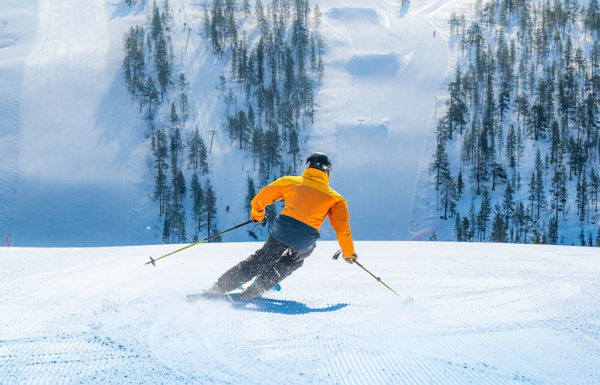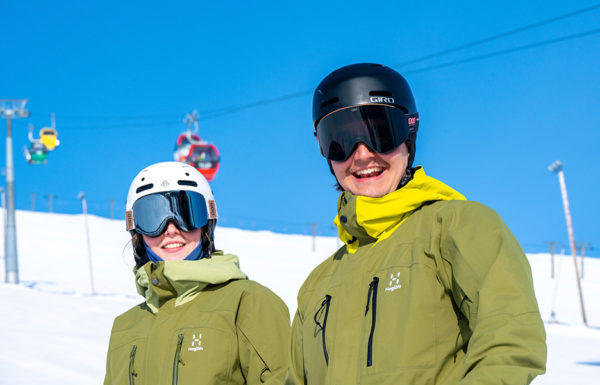First aid is aid given to an injured or ill person. The purpose of first aid is to support vital functions, alleviate suffering, prevent further injuries/symptoms and promote survival. Everyone has a duty to help, and first aid can be provided by anyone.
Resuscitation of an adult
1. Try to rouse the patient
If a person suddenly loses consciousness, determine whether they can be roused by being spoken to or shaken.
2. Call 112
If they do not wake up, call the emergency number 112, where the operator will make a more detailed assessment of the situation using a set of questions. If necessary, the emergency operator can guide the helper with telephone resuscitation instructions. Place the phone on speaker and continue to provide assistance. If there are two persons providing assistance, one will retrieve a defibrillator.
3. Check the patient’s breathing
The person who stays with the patient will figure out whether the patient can breathe normally.
– Place the patient on their back.
– Open the airways by extending the neck of the patient: lift the chin with two fingers and press the forehead with the other hand.
– Keep the airway open (support), feel whether the patient is breathing normally.
– Bring your cheek in front of the patient’s mouth and nostrils and feel for the potential airflow. At the same time, check if the patient’s chest is moving and if there are breathing sounds. This should not take more than 10 seconds. Do not spent time examining the mouth of the patient (i.e., determining whether there is anything inside). It is not recommended to lift by the jaw or to empty the mouth with fingers.
4. Compressive resuscitation
If the patient is not breathing normally, begin compressive resuscitation
– Place the patient lying on their back on a flat, inflexible platform.
– Quickly remove any thick clothing from the patient’s chest area, and expose the chest if possible.
– Apply compressions in the middle of the sternum.
– Place the palm of one of your hands at the compression point and your other hand on top of it.
– Press directly down on the sternum, arms straight. When pressing, do not bend the arms at elbows, press with the body.
– Compression depth is about 5 cm, no more than 6 cm for an average adult.
– The compression rate is 100–120 times per minute.
– Compressions should be performed continuously and with the highest possible quality.
– The thorax should return completely after the depression period.
– Pressing and rising phases are of equal length (50/50), in a piston-like motion.
– Do not lean on the chest.
– The number of compressions is 30 (count out loud).
5. Mouth-to-mouth resuscitation
Prior to resuscitation, open the airway by extending the head. Close the patient’s nostrils and have the helper place their mouth over the patient’s tightly and blow air into their lungs twice, so that the chest rises visibly.
– It takes about 10 seconds for two exhalations.
– After air is breathed into their lungs, begin compressions. The resuscitation continues at a rhythm of 30:2 until the emergency department assumes responsibility or the patient recovers.
6. Use of the defibrillator
When the defibrillator is brought to the patient, the user of the device takes a position opposite the resuscitator
– Turn on the device.
– Expose the chest.
– Attach the adhesive electrodes to the bare chest of the patient according to the instructions of the device and the pictures on the electrodes. At the same time, the second helper continues with uninterrupted compression resuscitation.
– Once the electrodes are in place, the device will analyze the heartbeat.
– The operator repeats aloud the orders given by the device, such as “clear the patient”.
– Once the device has analyzed the heartbeat, it will indicate either “defibrillating rhythm, clear patient, charging” or “no defibrillating rhythm, resume resuscitation”.
Defibrillable rhythm:
– The resuscitator interrupts the CPR and raises their hands to indicate that they are not in contact with the patient.
– The operator presses the flashing defibrillation button to deliver the shock.
– Immediately after shock, the device will request that resuscitation resume. At this point, the helpers rotate and the operator resumes compression resuscitation at a rhythm of 30:2 for the next two minutes.
– After two minutes, the device will reanalyze the heartbeat, and the helpers proceed as above.
Non-defibrillable rhythm:
– The device indicates that no shock will be delivered and compression resuscitation should resume at a rhythm of 30:2 for the next two minutes if the patient does not wake up.
– After two minutes, the device analyzes the rhythm again, in which case the operator follows the instructions given by the device.
112 app
112 Suomi is a mobile application for emergency calling and emergency location. Its additional services include an on-call list of different security operators and the transmission of official communications. 112 can be downloaded from the app stores for Android and iOS devices, free of charge.
The main benefit of the 112 app is that it speeds up emergency assistance. The caller’s exact location is automatically transmitted to emergency services, which speeds up the handling of emergency calls. Assistance can be sent from the nearest possible unit, and the fact that the exact location of the destination is known will speed up the arrival of the assistance.
Familiarize yourself with the app in advance and place its icon on the phone’s home screen so that it is quickly at your fingertips.
When you launch the app for the first time, it requires you to enter a phone number. Then, when you open the app, it opens directly to the screen with the Call 112 button. It is worth opening the app as soon as you download it and initialize it by entering your own phone number, so that in the event of an emergency, the app is ready to use immediately.
In order for location data to be communicated to emergency services throughout the emergency call and for the application to receive notification of hazard and regulatory notifications, the phone must always have location data turned on and the application must be given access to the location data.
FIRST AID INSTRUCTIONS
When providing first aid and first aid instructions, the importance and timing of the emergency announcement must be kept in mind. An emergency notification to the general emergency number 112 must be made immediately, if the patient can’t be roused by being spoken to or shaken, or their condition otherwise requires it.
1. Emergency call, dial 112
Put your phone on speaker as soon as possible in emergency situations that require first aid.
2. First aid given to an unresponsive person that is breathing normally
Always turn an unresponsive, normally breathing patient onto their side to secure their breathing. In this case, any vomitus will drain out of the mouth. Always ensure that the airways are not blocked. This also applies to a patient that is suspected of being injured. Observe the patient constantly to make sure that they are breathing.
If the patient shows irregular, infrequent and noisy breathing (agonistic breathing, indicative of a cardiac arrest). In case of abnormal breathing, do not turn the patient on their side, but instead, begin resuscitation. In this case, make sure that the patient is lying on their back.
3. Circulatory disorder (shock)
If the person is experiencing symptoms of a circulatory disorder (shock), lay them on their back and cover them to prevent heat loss. If there are no signs of injury to the feet, they can be lifted up.
4. Correcting limb misalignment in fractures, splinting
Manually stabilize the fracture in either the position it is in or the most painless position. This prevents further injuries, reduces pain and makes it possible for the patient to be moved safely.
Do not unnecessarily move the person. In first aid courses, temporary equipment is used to teach how to make a splint, in case of an extended evacuation period. Laypeople must not correct a misalignment under any circumstances.
5. Spinal injury
Support the patient’s spine and head manually so that their head does not twist sideways until professionals can handle the situation.
6. Mild head injury (concussion)
In case of a head injury, always consider the possibility of a concussion. Find out whether the patient can be roused, whether they’re talking and breathing normally, and whether there’s any sign of head trauma.
In case of a head injury (including sports, before resumption of activity),
the responders or a doctor will always make an assessment.
7. Stopping bleeding
In case of external bleeding, press on the wound to stop the bleeding. A dressing may be used as a follow-up measure. It has not been shown to be beneficial to lift the limb. Do not compress the major arteries. Cold treatment may be effective on minor cuts or bruises.
8. Low blood sugar, i.e., hypoglycemia
People with low blood sugar symptoms are given glucose tablets, or food or drink with high sugar content (4–8 glucose or sugar bits). If they lose consciousness, lay them on their side. Do not put anything in an unconscious person’s mouth.
9. Cooling burns
Correct first aid for burns is important for recovery. Cooling burns is widely used, although there isn’t much evidence of its efficiency. There is also no evidence of the preferred cooling method, temperature or cooling duration. However, it is recommended that active cooling be started as soon as possible with lukewarm water or cooling aids.
Cool burns for 10 minutes. Regarding extensive burns and children, consider the risk of hypothermia.
10. Identifying an acute cerebrovascular stroke (ACS)
The following symptoms of acute cerebrovascular stroke should be identified promptly: muscular fatigue, which presents as “sagging” of the mouth, impaired function of the hands, which is seen as a reduction in grip strength, and difficulty producing speech.
Identifying ACS with the FAST principle:
F (face) “hanging”, A (arm) weakness on one side / varying grip strength, S (speech = speech) difficulty producing speech, i.e., muddled speech, T (time) call 112 immediately.
11. Frostbite
First aid for a superficial frostbite, i.e., grade 1 frostbite (tingling, pricking sensation, white patches and/or numbness of the skin):
– Protect the skin area from wind
– Unbutton any tight clothing
– Warm up with a warm body part
– Move your limbs or ask the patient to move their limbs
– Drink something warm
– Add clothes
– Continue treatment until color and sensation return
– If recovery does not occur within 30 minutes, the frostbite is severe
– Don’t rub!
12. Hypothermia
In hypothermia, the human core temperature falls below + 35°C. In the case of a hypothermic patient, it is important to prevent additional cooling and to isolate the patient from the cold environment. Handling someone exposed to cold temperatures should be carried out with caution and calm, as excessive movement may cause ventricular fibrillation in a cooled heart. Avoid lifting and moving the limbs to prevent cold peripheral blood from reaching the core of the body to aggravate cooling.
The emergency care provider or treating physician should be made aware of the course of events and the duration of exposure.
If the victim of hypothermia is able to move
– Change to dry clothes and cover the head
– Get them to move slowly
– Take them to shelter (room temperature)
– Give them a warm, sugary drink.
– Once inside, place hands and feet in approx. 42-43°C in water
– A conscious, shivering victim can be taken to the lower seats of a lukewarm sauna (45-50°C) – keep in mind that fluid supply is important!
If the victim of hypothermia is incapacitated
– Change to dry clothes and cover the head
– Avoid moving the patient, keep them in a horizontal position
– Cover with blankets, etc. & use a thermal blanket
– Take them to shelter (room temperature)
– Transport the patient in a horizontal position
– Give them a warm, sugary drink.
– Call 112, monitor their breathing.
If the victim of hypothermia is unconscious
– Call 112.
– Handle the patient with care
– Place in the side position
– Do not remove any clothing
– Cover with blankets, etc. & use a thermal blanket
– If the patient is not breathing, begin resuscitation
– If possible, leave the decision on compression resuscitation to the professionals
– Transport the patient to the hospital in a horizontal position
Note! Rapid external heating of the patient can cause dangerous post-cooling of the internal organs















